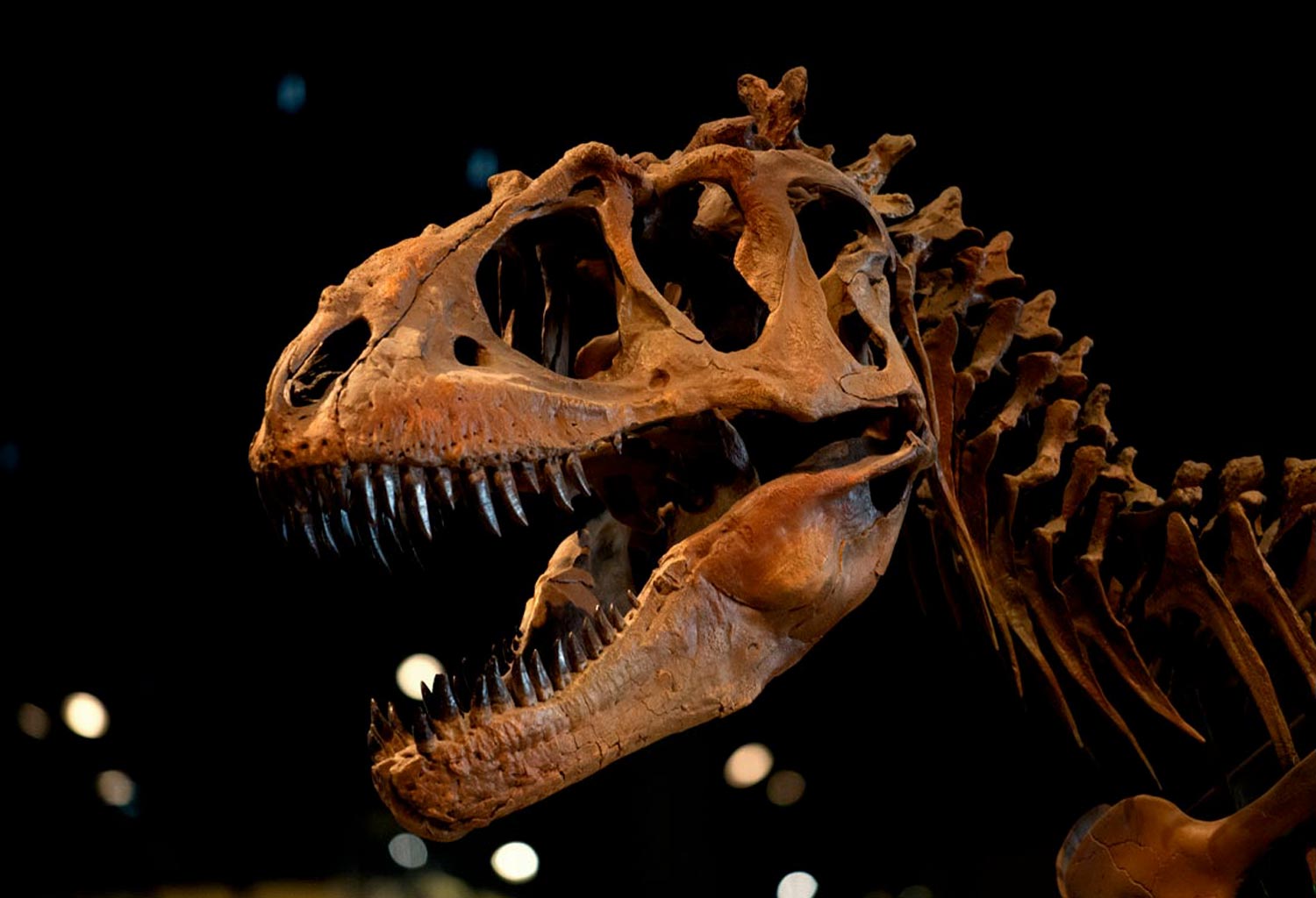Utah’s Rock Stars
Photos by Forrest Anderson
I’m going on a dinosaur hunt and, since many dinosaurs lived in tropical forests, I’m heading for … the Utah desert. That’s right, that arid Western state with the spectacular cliffs and rock formations.
Utah has one of the world’s most complete exposed records of the earth’s geologic history, which makes it a real-life Jurassic World of new dinosaur discoveries. Dinosaurs may have been dead for millions of years, but they’re still celebrities in Utah. A spikey armored dinosaur that evolved from an Asian ancestor; a set of dinosaur tracks found in Washington County, Utah; a 70-foot-long diplococcus skeleton excavated south of Blanding, Utah; a megabattle between scientists and President Donald Trump’s administration over drilling and mining in areas rich in dinosaur fossils are among the dinosaur topics that typically make the news in the state.
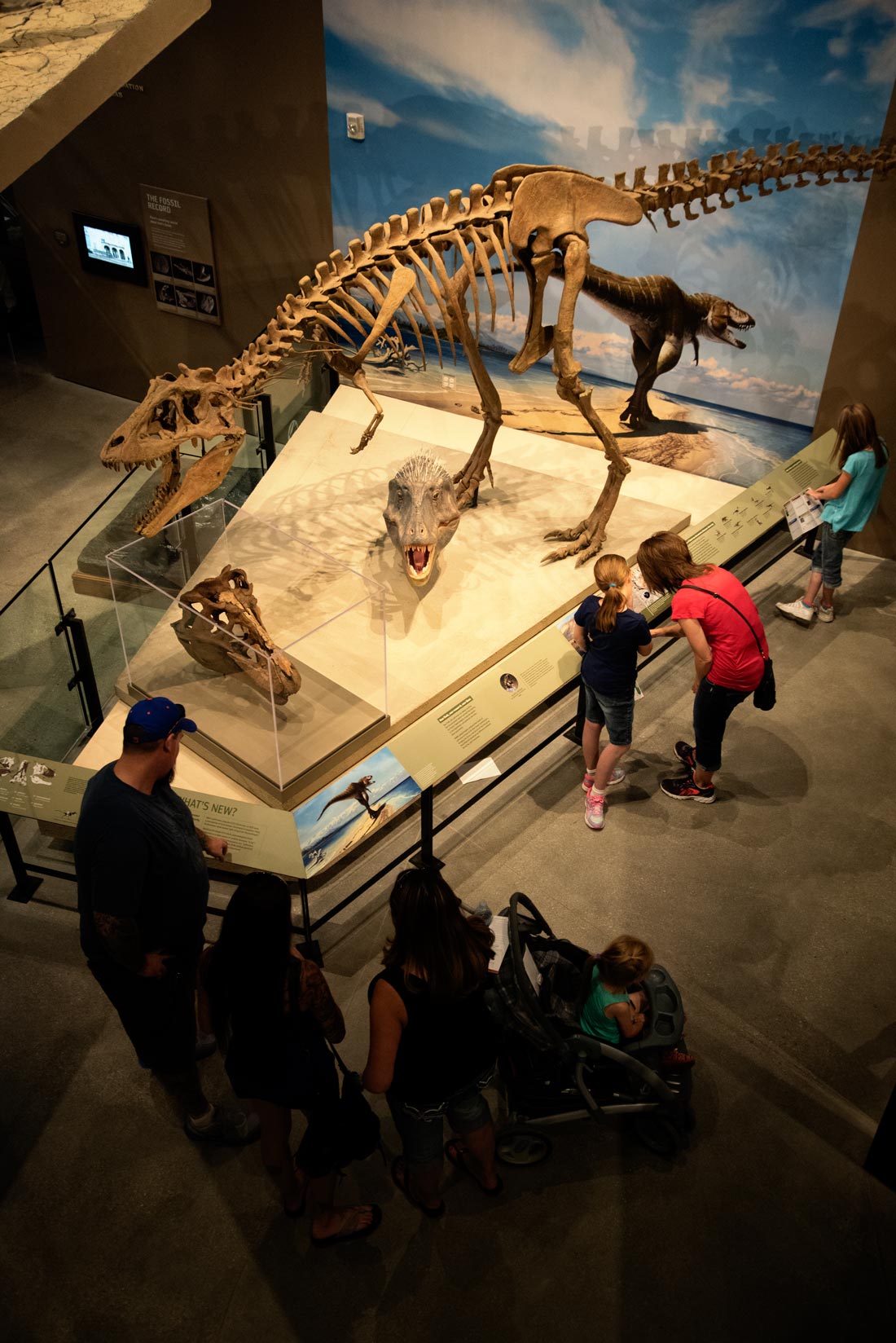
Dinosaurs and their fans at the Museum of Natural History in Salt Lake City.
Utah is in a golden age of paleontology in which new evidence about dinosaurs is discovered almost weekly. Researchers have found more than 100 new dinosaur species in Utah in the past 25 years, and there is still lots of room to explore.
Utah’s fossil record spans almost the entire Age of Dinosaurs plus providing a plethora of information about the habitat in which they lived and the way in which they evolved over time. The fossils have enabled paleontologists to determine that North American tyrannosaurs started out small and grew to monster size over a span of 16 million years.
Dinosaurs lived during the Mesozoic period, some 245 million years to 65 million years ago, and Utah’s fossil record spans most of this period. The Mesozoic is divided into the Triassic (near the end of which dinosaurs appeared), the Jurassic and the Cretaceous periods. Utah's fossil record includes both bones and more than 30 sites of dinosaur tracks that reveal the animals’ migration and social patterns.
Utah’s eastern and southern deserts are stacked with rock layers that document the age when dinosaurs lived. Many dinosaurs found in these rocks are unlike species found anywhere else. Among them are armored herbivores with tail clubs, long-necked herbivores, small early tyrannosaurs the size of a Labrador retriever, ancient birds, dinosaurs with long sword-like horns, and ostrich-like dinosaurs.
Here are some of Utah's most famous rock stars at the Museum of Natural History in Salt Lake City:
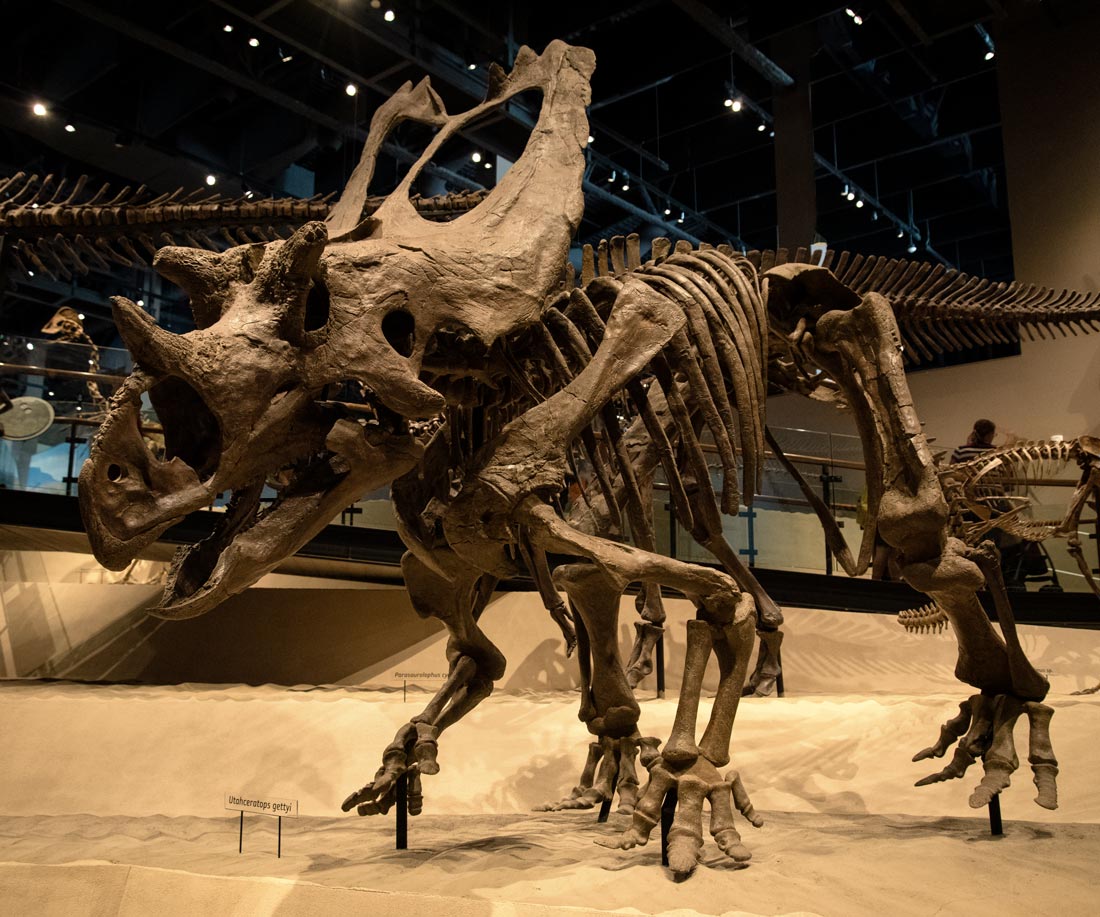


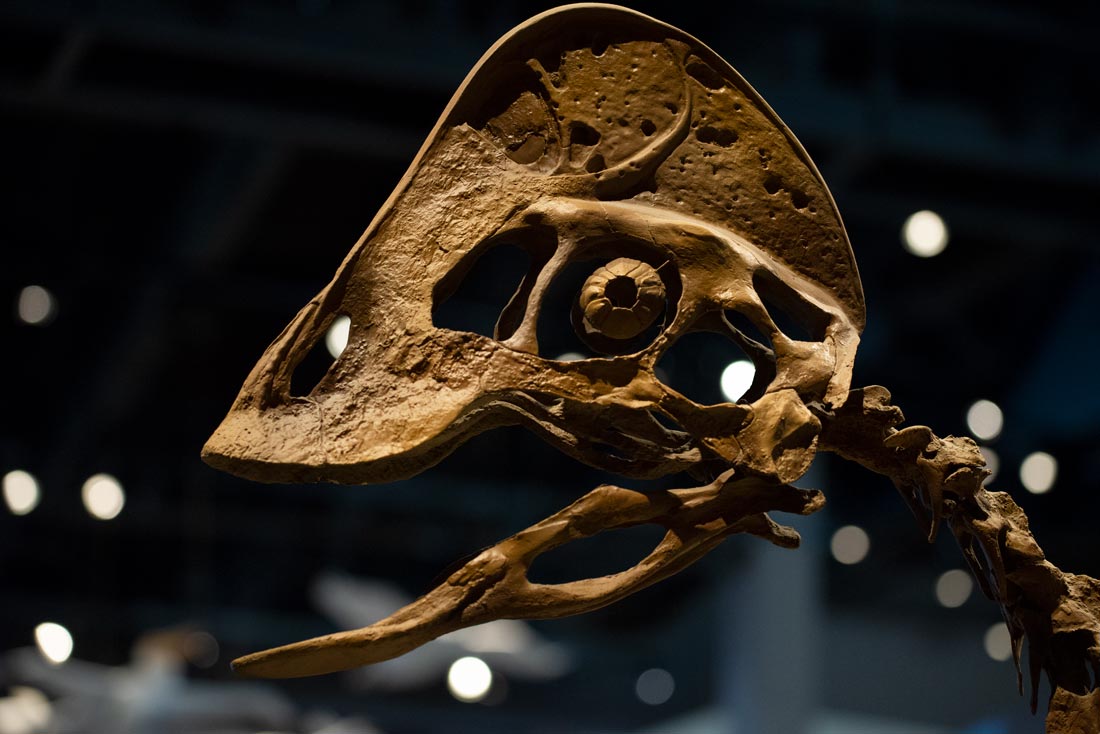
In the Middle Jurassic period, an interior seaway invaded Utah from the north. It added mostly marine invertebrates to Utah's fossil record, but in the Red Fleet Reservoir area of northeastern Utah, bones of giant marine reptiles (pliosaurs and ichthyosaurs) have been found, along with dinosaur tracks. In the coal mines of Carbon, Emery, and Grand counties dinosaur tracks crisscross the ceilings of coal mines. Fossil trees have been found surrounded by the tracks of dinosaurs that fed upon their leaves.
Thousands of rare fossils pepper the Bears Ears National Monument in Utah, which former President Barack Obama designated a national monument. However, President Trump slashed the size of the monument by 85 percent. Scientists say the lands that were cut hold thousands of Native American artifacts and possibly the world's densest cache of fossils from the Triassic period. Cutting these lands from the monument opens them to mining, expanded grazing, and cross-country trekking by off-road vehicles. Scientists and five Native American tribes sued the Trump administration in federal court, arguing that the 1906 Antiquities Act used to create Bears Ears only allows presidents to establish monuments but not to drastically reduce them. The suit claimed that the cuts represent an extreme overreach of authority. The lawsuit is a crucial one – winning it could safeguard the boundaries of the 158 national monuments created by presidents. Losing it could mean that presidents would have new powers to downsize them.
A similarly rich fossil record in Grand Staircase-Escalante National Monument helped make the case for that monument to be established by former President Bill Clinton in 1996. Trump cut it in half in 2017.
Bears Ears' record begins more than 340 million years ago, when the supercontinent Pangaea spanned much of the earth. A tropical sea that covered the area began to fill with sediment shed by the uplifting Rocky Mountains, leaving thousands of prehistoric sea creatures, mammallike reptiles, and dinosaurs entombed in hardened mud. Some of those fossils help tell the story of a mass extinction event 252 million years ago that killed 96 percent of marine species and 70 percent of terrestrial ones, clearing the way for dinosaurs. Others chronicle a second mass extinction some 50 million years later that wiped out 76 percent of terrestrial and marine life.
The largest concentration of Triassic fossils in the United States and possibly the world have been found in the Valley of the Gods that was formerly part of the Bears Ears National Monument, including rare fragments of phytosaurs — six-meter-long crocodilelike creatures - that roamed those lands 212 million years ago. Many other sites in the area remain to be investigated.
Still inside the Bears Ears National Monument is a bed of more than 250 dinosaur tracks, but most of the monument’s paleontological treasures are now outside the monument where they are exposed to off-road vehicles and mining. Because they are no longer in the monument, scientists can’t get funding for research that could enable them to get to the fossils before looters do. Dinosaur poachers are a problem because there is a lucrative private collectors’ market for dinosaur bones, with some selling for millions of dollars. Removing vertebrate fossils from federal lands is a crime for nonscientists, but outside monument boundaries, anyone can gather and sell them. Paleontologists have tried to do as much research and excavation as they can before their funding tied to the area’s former national monument status dries up. Paleontologists can still get permits to investigate and dig for fossils on former Bears Ears lands, but the process will be more difficult.
Utah’s dinosaurs are so plentiful that scientists often excavate them not one at a time but in huge blocks of stone that they then transport back their labs to gradually excavate the contents. One such nine-ton block contained the biggest fossil trove ever found of the giant Utahraptor, a feathered dinosaur with a huge sickle claw on each second toe. These fossils may help resolve the question of whether the Utahraptor hunted in herds. The rock contains at least six Utahraptors, which are changing the understanding of Utahraptor anatomy. Scientists as a result now believe that young Utahraptor dinosaurs were lightly built while adults were heavily muscled.
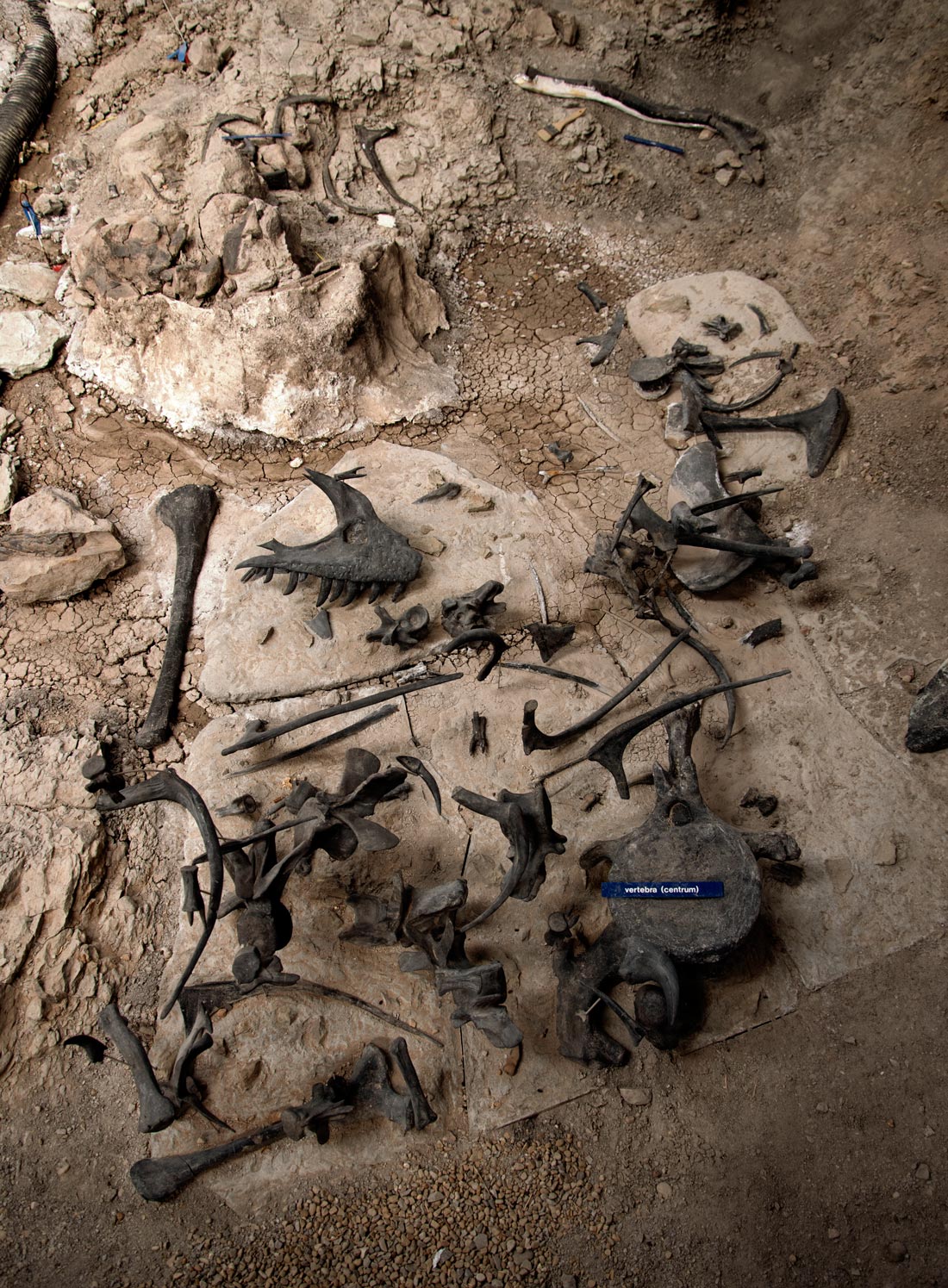
Dinosaur bones at the Cleveland-Lloyd Dinosaur Quarry near Price, Utah.

Paleontology lab at the Museum of Natural History.
Research by Utah paleontologists also has revealed that a larger and more diverse group of vertebrates could fly than they had thought. New information about pterosaurs came from a rock formation in northeastern Utah called the Saints and Sinners Quarry that was believed to have been an oasis in a dune-covered desert that drew animals during droughts. The area has thousands of Triassic bones. Researchers at Brigham Young University in Provo, Utah, have discovered part of the face, the roof of the skull, the lower jaw and part of a wing of a new pterosaur species, Caelestiventus (heavenly wind) hanseni. They believe it died in soft sand or sediment that hardened to rock, keeping the fossil intact. CAT scans reveal that the fossil, which still is partially encased in rock because it is so fragile, was a juvenile about five feet wide. In later eras, these animals reached the size of small airplanes. It is believed that this animal hung around the watering hole, snapping up smaller animals that went there to drink.
Utah was once part of a land that paleontologists call Laramidia which was created 90 million years ago when rising seas flooded the middle of North America and divided it in two. Laramidia, on the west, is today buried under the western states, but it can be accessed in parts of Utah because of erosion. Researchers have unearthed fossils of tens of thousands of plants and animals including dinosaurs, crocodiles and turtles in a 2,600-foot-thick deposit in the Kaiparowits formation in the Grand Staircase-Escalante area which dates from 77 million to 75 million years ago.
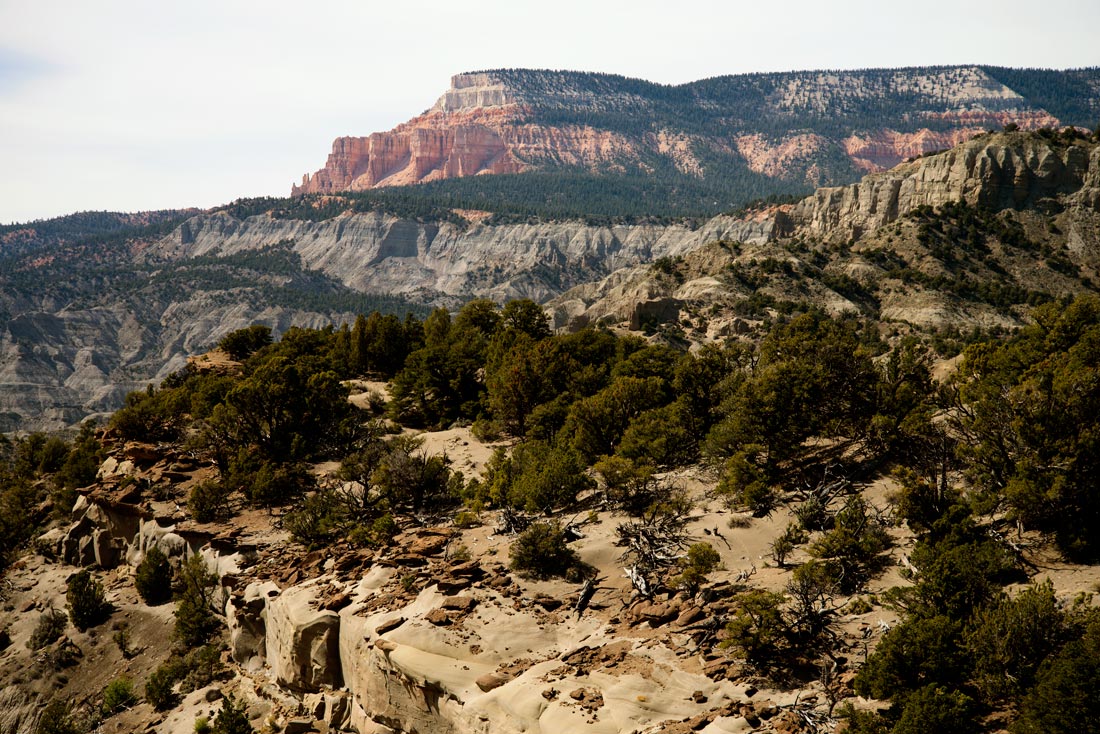
Kaiparowits Plateau.
Laramidia had a surprising diversity of large and small dinosaurs. Quickly deposited layers of sand and mud buried the fossils in pristine condition. Skeletons are in one piece with the bones arranged in the proper order, sometimes with fossilized skin.
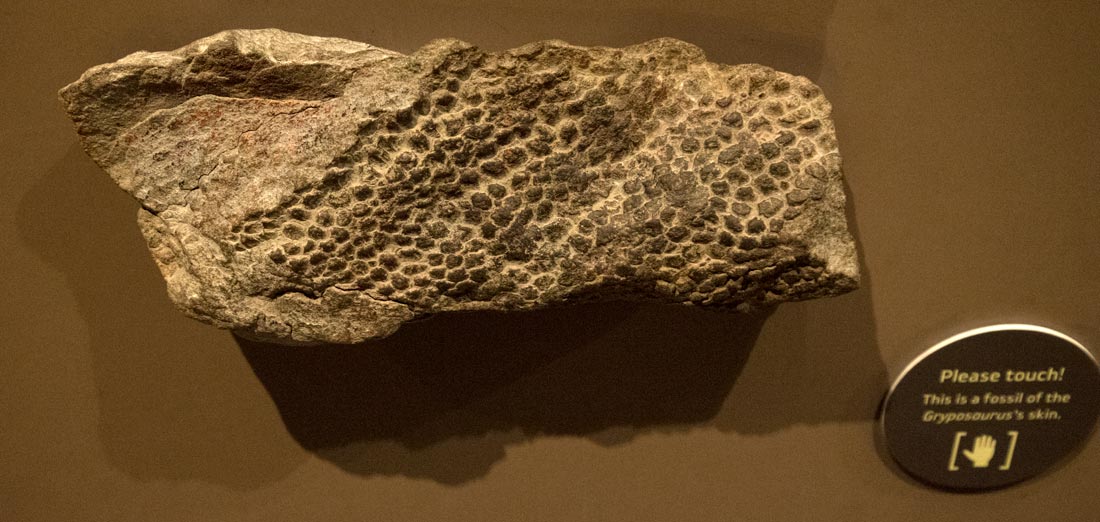
Skin imprints at the Natural Museum of History.
Plants are so fresh that their leaves can be peeled off the rocks. When they are illuminated beneath an epifluorescence microscope, their leaf coverings fluoresce bright green to reveal their cellular structures. Among the Kaiparowits’ biggest discoveries have been 21 new dinosaurs. The skull of a 30-foot-long hadrosaur or duck-billed dinosaur with 800 teeth; a seven-foot-tall dinosaur that was possibly feathered and two-footed; dome-headed dinosaurs; armored ones; sickle-clawed and horned ones, including a rhino-sized one with 15 horns on its head, have been found. Some have elaborate frills on their heads. An herbivore with a skull seven feet long, large nose and forward-facing horns was found. Two new species of tyrannosaurs have been found on the plateau - a 12-foot-tall Teratophoneus currei (monstrous murderer) tyrannosaur and Lythronax argestes (king of gore), at 81 million years old the oldest tyrannosaurid known to science. The Utah dinosaurs differ from those in other western states in that almost every one found has been a new species. Utah’s dinosaurs evolved differently from those in other areas, possibly because of different climate zones and vegetation. They also were more flamboyant, with horns, spikes and frills.
The Kaiparowits also has yielded some of the greatest crocodile and turtle diversity in the ancient world - six crocodile species and 17 turtle species. One three-foot-long turtle died pregnant, her body full of eggs.
The Kaiparowits’ plentiful fossil record has enabled Utah scientists go far beyond finding “the big one” or “the weird one” to working out just about any question they have about how the dinosaurs livedand evolved.
In the Late Cretaceous period, southern Utah was home to nine species of animals that weighed well over 2,000 pounds. Africa today has only few animals that large: elephants, giraffes, hippopotamuses, buffaloes and rhinoceroses.
Scientists believe that the huge Utah animals were supported on a small land mass because the forests contained tons of vines that made them into a huge salad for the creatures. No other forest is so heavily dominated by vines in the fossil record.Seventy-five million years ago, the Kaiparowits wasn’t a desert. Located about 60 miles from the sea in a flat basin crisscrossed by rivers, lakes and ponds, the Kaiparowits was swampy. Trees grew that now remain as petrified wood. Giant pine trees draped with moonseed vines towered over a wet forest floor on which grew gingers, ferns, duckweed, water lettuce and floating, flowering plants.Fossils indicate lily pads, water lettuce, swampsand large rivers. The vegetation may have been so lush that the animals were not motivated to travel long distances to get food, so they evolved on their own. This situation can be seen today in tropical rain forests. The specialized adaptation that created Utah’s unique dinosaur species eventually may have become a problem as environmental conditions changed, which could explain why fewer large dinosaurs were found in the fossil record as it approached the dinosaurs’ mass extinction around 66 million years ago, after which mammals diversified and thrived.

Fossilized leaf.
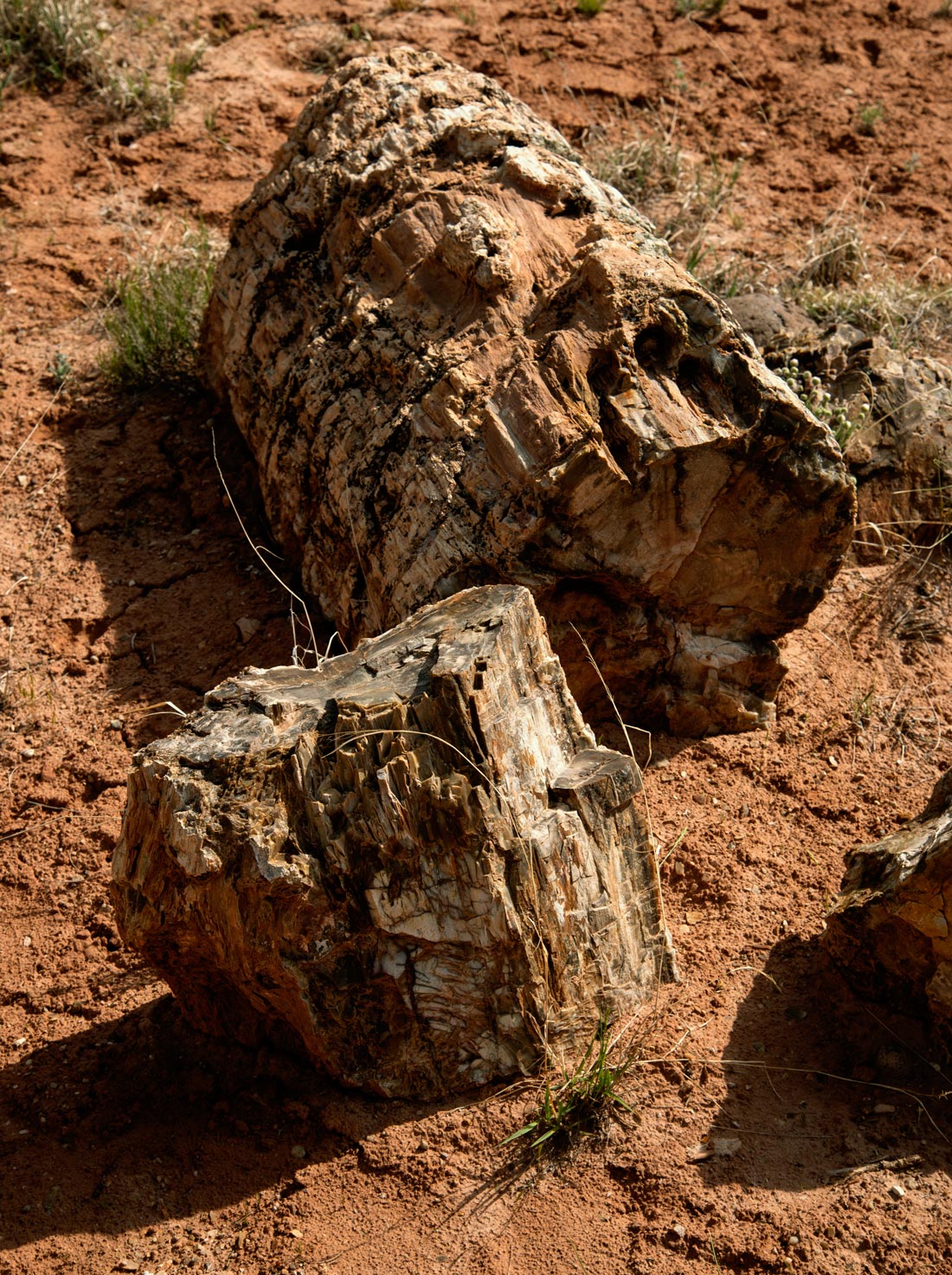
Petrified wood from the Grand Staircase-Escalante area.
A large sea that covered many parts of the state eventually gave way to lakes that then dissipated, leaving fossil records of the lakes’ inhabitants that were later exposed as the lakes vanished when local precipitation decreased. During the early Cretaceousperiod, Utah was home to the pliosaurid Brachauchenius, a sea monster. The Great Salt Lake is a remnant of the lakes.
Utah manages its dinosaur herds well, with a plethora of places where you can explore on your own dinosaur safari in the state. Here are the most prominent places to hang out with the beasts:
Northern Utah
The Natural History Museum of Utah
University of Utah, Salt Lake City
You can spend an afternoon walking through the Age of Dinosaurs on a winding elevated pathway of dinosaur skeletons, view a dinosaur dig from above, and see the latest dinosaur finds from Utah field sites at this world-class dinosaur museum. See a duck-billed dinosaur, a Utahrapter, an Allosaurs and a huge Stegosaurus as well as the world’s largest collection of horned dinosaur skulls. This is the perfect place to start to get an overview of the Utah dinosaur scene.
The Ogden George S. Eccles Dinosaur Park
Ogden, Utah
Not everyone likes seeing dinosaur skeletons without their skin on. If you prefer a Jurassic World experience where the dinosaurs are wearing hides, this eight-acre outdoor museum is your best bet. You can walk around and imagine what it would have been like to live in the Age of Dinosaurs. The park has realistic life-sized models of more than 125 dinosaurs that have been produced from research using fossil remains. It also has prehistoric crawlers, predators, marine creatures and flying reptiles, a 16,000-square-foot museum, large paleontology laboratory, offices and a lecture hall. You can compare your footprints with dinosaur ones, unearth dinosaur fossils in a sand pit and play on a dinosaur-themed playground.
Museum officials try to keep up with changing research, including adding a new Utahrapter and a Tanystropheus to the park. They decided to add the new Utahraptor because of recent findings that Utahraptors had feathers and a chicken-like stance. The park already had a Utahrapter, but this one will be smaller to reflect the new research. It will be placed next to the earlier model to show how paleontology is evolving with new fossil discoveries. The Tanystropheus is a mysterious animal about 20 feet long with an long neck that may have enabled it to stand on shorelines and dip its head into water to catch fish. The museum also decided to give the Brachiosaurus a new skull to reflect new research on it.
The Museum of Ancient Life
Thanksgiving Point, Lehi, Utah
This museum has one of the largest collections of mounted dinosaur skeletons in the world. The more than 60 dinosaur skeletons include two tyrannosaurus rexes, the world’s most complete Stegosaurus, and a 120-foot specimen of the largest dinosaur ever discovered, the Supersaurus. You also can explore more than 100 reconstructed flying reptiles, thousands of ancient fossils and 50 interactive exhibits that go through every geological period to modern times. You can take a paleontology class or watch a 3D movie at the museum’s six-story Mammoth Screen theater.
The Brigham Young University Museum of Paleontology
Brigham Young University, Provo, Utah
This small museum is recognized for having one of the most valuable Jurassic dinosaur collections, including a 150-million-year-old dinosaur egg. The museum was built around the many huge dinosaur fossils collected by “Dinosaur Jim” Jensen, a colorful Utah paleontologist and artist who also pioneered techniques in mounting and casting dinosaur bones. The museum has the world’s only complete skeleton of the predatory Torvosaurus, which is 30 feet long and 12 feet high. There is a viewing gallery where you can watch scientists and students process fossils and a section where people can touch fossils. This museum on the campus of Brigham Young University in Provo displays only the best of its collection of dinosaur bones. Most of the collection is in storage under the school’s football stadium.
Northeastern Utah
Dinosaur National Monument/Utah Field House of Natural History State Park Museum
Vernal, Utah
This is the greatest dinosaur destination in Utah, with the largest quarry of Jurassic dinosaur bones ever discovered. About 350 tons of fossils and rocks, including full skeletons, have been excavated from the site. The quarry's great wall of dinosaur bones features nearly 1,500 Jurassic-era fossils and multiple interactive exhibits. The museum also has a dinosaur garden with full-sized dinosaur replicas.
A 90-foot long Diplodocus skeleton is in the museum rotunda. In a small ravine, you can try to distinguish fossils on a rock wall A dig site simulation illustrates the science and sequence of Jurassic fieldwork, including the discovery and removal of fossils from rock. In the Fossil Lab, you can use a brush to reveal replicas of fossils. You can go on a hike and see dinosaur fossil bones eroding from the rocks.
Red Fleet State Park
In Northeastern Utah along the shore of the Red Fleet Reservoir is a large site of more than 400 tracks of at least two types of dinosaurs. You can see nearly perfect dinosaur footprints here at the end of a beautiful hike.
Central Utah
The Cleveland-Lloyd Dinosaur Quarry/Jurassic National Monument
33 miles south of Price, Utah partly on unpaved, graded road
Discovered by 19th century cowboys and sheepherders who drove their animals through the area, this quarry has the densest collection of Jurassic dinosaur fossils ever unearthed. It may have been formed by floodwaters that deposited hundreds of carcasses there. The quarry has yielded 10,000 to 15,000 bones, including some from 46 allosaurus skeletons. The quarry was designated Jurassic National Monument this year. Utah’s political leaders, who have long opposed presidential national monument decrees, praised this one because it was confined to a small area surrounding the scientifically significant objects and was made with congressional approval as opposed to White House action.
Most of the bones in the quarry are of carnivores like the Allosaurus, Utah's state fossil. One of the mysteries of the quarry is that bones from carnivores outnumber those of their prey three to one, the opposite of what would usually be expected.
You can see a working dinosaur quarry, including watching paleontologists and volunteers at work during the field season. Museums worldwide display mounted skeletons of the meat-eating dinosaur Allosaurus cast from specimens collected at the quarry. Excavations at the Cleveland-Lloyd Quarry have yielded the remains of over 70 individual dinosaurs, two-thirds of which are carnivores and mostly of the genus Allosaurus, Utah's official state fossil.
Utah State University Eastern Prehistoric Museum
Price, Utah
This museum displays a cast of the Huntington Mammoth, ancient artifacts from the Fremont Indians and skeletal remains of the Utahraptor which was discovered in 1989. While researching at the museum for the film Jurassic Park, director Steven Spielberg was so inspired by the Utahraptor that he gave it a featured part in the film Jurassic Park as the velociraptor.
Museum of the San Rafael
Castledale, Utah
This small museum has dinosaur foot impressions, dinosaur skeleton reconstructions and a cast of a Tyrannosaurus skull as well as complete skeletons from the Jurassic and Cretaceous periods, many dinosaur tracks removed from local coal mines, dinosaur eggs and other fossils. The museum supplements the Cleveland-Lloyd Quarry with additional paleontological displays of herbivores and carnivores and of archeological exhibits going back to the Ice Age.
Its collection has a replica of a fossilized dinosaur egg believed to contain an embryo, skeletons of Allosaurus, Chasmosaurus and Albertosaurus dinosaurs and a huge skull of a tyrannosaurus rex.
Southeastern Utah
Moab Giants Dinosaur Park and Museum
This complex in Moab has a half-mile interactive paleo safari with more than 100 reconstructions of life-size dinosaur species and the tracks they left.
Museum of Moab
This museum is closed for renovation until early 2020, but it’s worth keeping in mind because it has massive dinosaur bones as well as archeological artifacts from Moab and the Four Corners region.
Dinosaur Tracks Trail near Moab
This is a .2-mile easy hike above the Colorado River to a boulder that has tracks of the three-toed Allosaurus.
Copper Ridge Dinosaur Trackways near Moab
This is a 15-minute easy hike to see tracks in the red rock that were likely left by the Apatosaurus and Diplodocus.
Poison Spider Dinosaur Trackway
This .3-mile walk has some of the clearest dinosaur footprints you’ll ever see, along with petroglyphs. The area around Moab was covered with huge sand dunes 90 million years ago. Between the dune fields were scattered flat areas of wet sand, shallow ponds and streams. Dinosaurs left their footprints in them, they were covered by shifting dunes and were preserved. Millions of years later, the sands had turned to stone. Stones containing the tracks fell out of the cliffs above and split, exposing the tracks.
The Dinosaur Museum
Blanding, Utah
This fun museum in Blanding has a large display of dinosaur skeletons, dinosaur eggs and one of the largest collections of dinosaur skin imprints in the world as well as an exhibit on the role dinosaurs have played in pop culture, media and movies. It includes the dinosaur used in the original King Kong movie from 1933.
The exhibits include how dinosaurs were distributed globally and the latest in dinosaur skin research.
Southwestern Utah
St. George Dinosaur Discovery Site at Johnson Farm
How would you like to find dinosaur tracks on your property? Sheldon Johnson had that spooky experience in 2002. This is the most significant dinosaur track site in western North America, with some of the oldest and best preserved dinosaur footprints in the world. It has thousands of dinosaur tracks and other fossils from an ancient shoreline as well as skeletal reconstructions, rotating displays and interactive areas. The site was preserved and a museum has been built over it. The site has been called "the most important in the world for researchers working on early Jurassic footprints." The site gives visitors an idea of how dinosaurs walked and behaved.
Southern Utah
Big Water Interpretive Center and Dinosaur Museum
Big Water, Utah
This center explains the Grand Staircase-Escalante National Monument, which is one of the world’s best windows into the earth’s geological history and sites for dinosaur research. Grand Staircase/Escalante National Monument is the last great, largely unexplored dinosaur bone yard in the 48 states.
Hanksville-Burpee Dinosaur Quarry
10 miles northwest of Hanksville, Utah
This 10-acre quarry on a dirt road is a fossil hunter’s mecca. Scientists first started researching here over a decade ago and the excavation site has yielded the discovery of thousands of pounds of dinosaur bones. This is a site for the more advanced and patient dinosaur searcher. It has a summer volunteer program and expert-led quarry tours in the summer.
Moccasin Mountain Dinosaur Track Site
Near Kanab, Utah
On this half-mile round trip hike, view hundreds of dinosaur tracks with at least six different types of footprints from the early Jurassic time period. The site contains some of the most diverse vertebrate tracks for the Early Jurassic period in North America.
Check out these related items
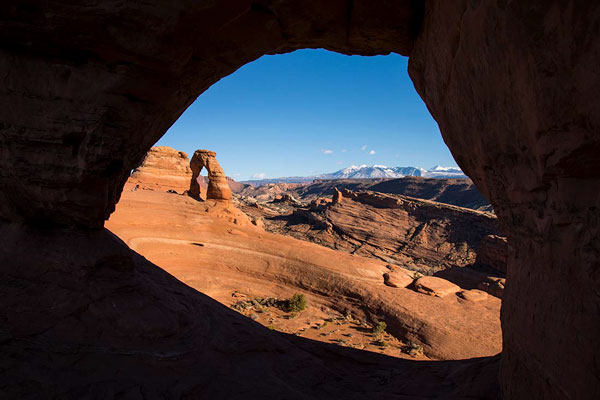
Visit Utah’s National Parks
Utah state and local governments and organizations are chipping in to keep national parks operating during the government shutdown.

The Elephant Needs the Room
Despite tough bans on ivory trade, Africa's elephants are declining in numbers because of poaching and trafficking of illegal ivory.

The River That Keeps on Giving
The mammoth Colorado River is the lifeblood of the southwest United States, supplying water and power for cities and agriculture.
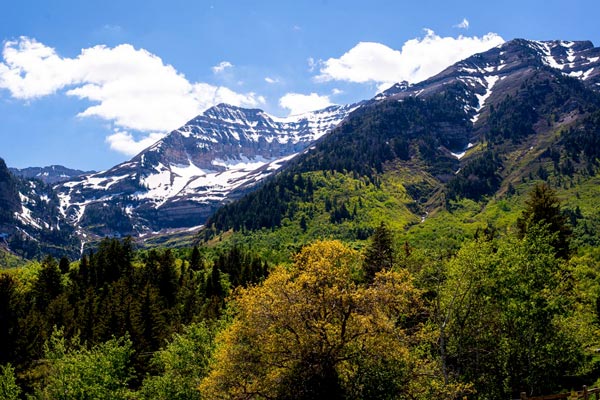
Springtime in the Rockies
It's springtime in Utah's Rockies. Photographer Forrest Anderson captured the stunning scenery.
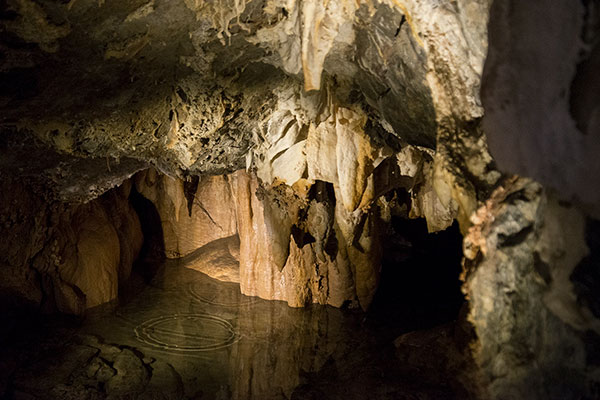
Timpanogos Cave
A wierd and wonderful cave system holds the heart of Mt. Timpanogos, near Provo, Utah.
